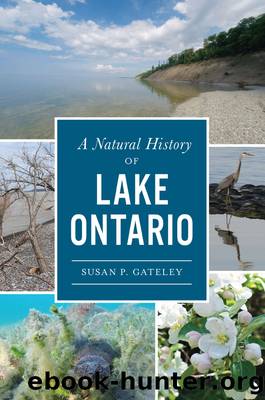A Natural History of Lake Ontario by Susan P. Gateley

Author:Susan P. Gateley
Language: eng
Format: epub
Publisher: Arcadia Publishing Inc.
Published: 2021-01-15T00:00:00+00:00
STONE STORIES
The lakeâs south-shore beaches with their colorful variety of rocks are a pebble pickerâs delight. As it moved southwest, the glacier picked up rocks from different locations. When it melted away, the rocks remained behind, dumped together in a multicultural mix. Ancient metamorphic gneiss (rhymes with âmiceâ) from the Thousand Islands area and the Canadian shield, granite and dark sparkly schist from the Adirondacks and Ordovician limestone from the Canadian side of the lake now lie side by side on the beach. They and other sedimentary and metamorphic rocks create a delightful mosaic of colors, textures and shapes on south-shore beaches.
Around Sackets Harbor and Chaumont as well as on the Canadian shore around Kingston and eastern Prince Edward County, gray limestone pebbles predominate. Most of the beach pebbles on New Yorkâs south shore are of either various colors of sedimentary sandstone or limestone or have metamorphic origins. Sometimes, the keen-eyed beachcomber may also see a few rocks of human origins. You might occasionally encounter water-rounded bits of concrete or brick that recall the fate of a cottage or some other man-made structure that once stood on an eroding shore. Iâve found odd water-rounded âpumiceâ-like clinkers and bits of slag as well as pieces of gray dolomite rock broken off of some of the boulders that have been imported by people to protect shorelines. Once or twice, Iâve found water-rounded gray beach stones from these imported boulders that have hollows, or âvugs,â containing small crystals. So you never know what oddities might show up among the native sandstone or other pebbles left by the glacier on the neighborhood beach.
Freshly eroded rocks recently released from the shoreline banks and bluffs usually have angular shapes and edges. After a few years of beach life, they become the water-rounded pebbles that skitter and roll so readily underfoot. However, a close look at the stones still embedded in the bluff âs clay reveal that some of them show signs of some water-rounding that must have occurred long before Lake Ontario existed. Now and then, a really big rock ends up on the shore or in the lake. They can be of various types; some are sandstone or limestone, others are metamorphic granite or gneiss. These are glacial erratics, some of which were carried long distances by the ice.
Not long ago, I encountered two refrigerator-sized boulders recently eroded out from the shoreline. Both appeared to be of identical granite-like rock, ancient metamorphic rocks that may have originated from the Canadian Shield to the north. Both were clearly somewhat water- or ice-rounded.
I thought they looked like siblings. Perhaps they were both broken off of a larger mass of rock eons ago by the glacier. Perhaps they were then dragged around and shaped by the ice. Or perhaps, after forming a billion year ago miles below the earthâs surface in the deep time of geology, they somehow journeyed to the surface to then be shaped by water action. Maybe at some point in their lives they were
Download
This site does not store any files on its server. We only index and link to content provided by other sites. Please contact the content providers to delete copyright contents if any and email us, we'll remove relevant links or contents immediately.
The Lonely City by Olivia Laing(4751)
Animal Frequency by Melissa Alvarez(4395)
All Creatures Great and Small by James Herriot(4233)
Walking by Henry David Thoreau(3895)
Exit West by Mohsin Hamid(3778)
Origin Story: A Big History of Everything by David Christian(3650)
COSMOS by Carl Sagan(3558)
How to Read Water: Clues and Patterns from Puddles to the Sea (Natural Navigation) by Tristan Gooley(3409)
Hedgerow by John Wright(3277)
The Inner Life of Animals by Peter Wohlleben(3261)
How to Read Nature by Tristan Gooley(3250)
How to Do Nothing by Jenny Odell(3235)
Project Animal Farm: An Accidental Journey into the Secret World of Farming and the Truth About Our Food by Sonia Faruqi(3178)
Origin Story by David Christian(3148)
Water by Ian Miller(3129)
A Forest Journey by John Perlin(3027)
The Plant Messiah by Carlos Magdalena(2883)
A Wilder Time by William E. Glassley(2818)
Forests: A Very Short Introduction by Jaboury Ghazoul(2790)
